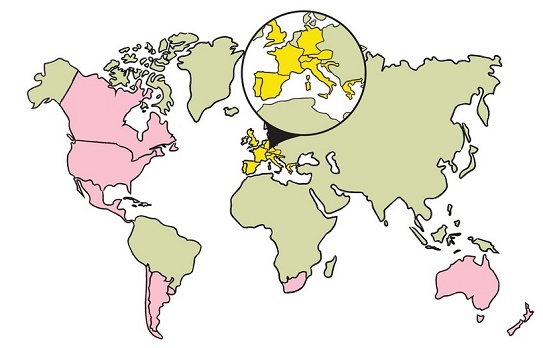Pennsylvania Wine Production
Pennsylvania has a growing wine industry with a diverse climate that allows for the production of a wide range of wine styles. The state has over 300 wineries producing 1.8 million gallons of wine annually
1,800 Hectares
(4,500 Acres)
6.8 million Litres
300+ Vineries
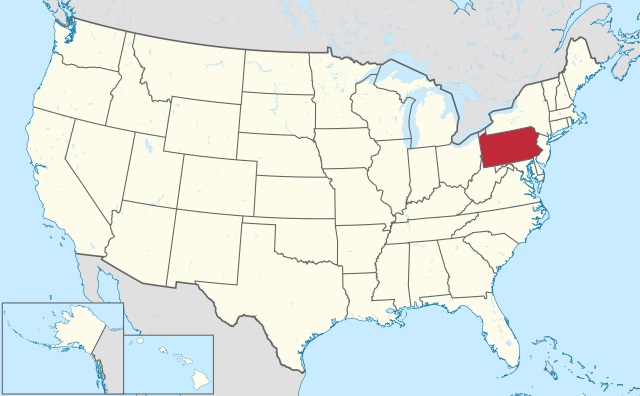
Pennsylvania Wine Production
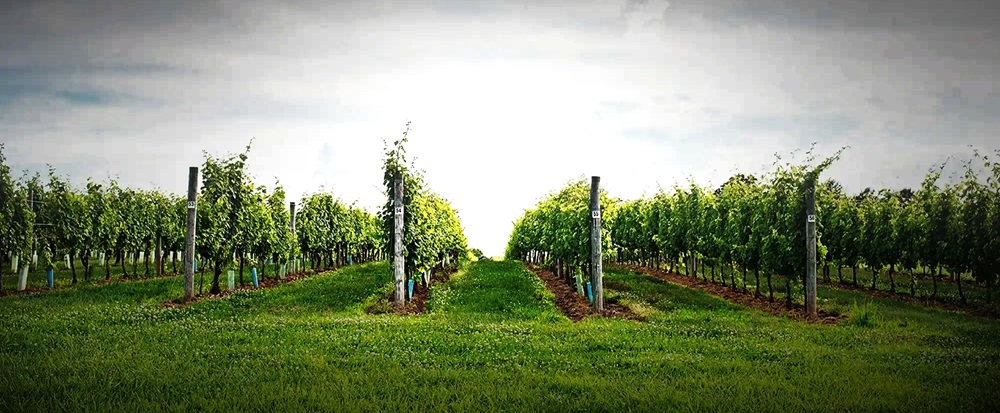
Pennsylvania’s wine industry dates back to the 1600s, when early settlers attempted to cultivate European grape varieties. However, the humid climate and native pests like phylloxera made it challenging.
Over time, local wineries adapted by growing both vinifera (European varieties), hybrid, and native grape varieties.
The wine industry is growing in reputation, with wineries experimenting with cool-climate viticulture and producing quality reds, whites, and unique hybrid wines.
Wines range from dry reds and whites to sweet wines.
Some wineries are specializing in ice wine.
Pennsylvania experiences high humidity, which can lead to disease pressure, making fungal-resistant hybrid varieties more common.
Climate and Terroir
Pennsylvania has a humid continental climate, which varies from cold winters and short growing seasons in the north, to longer and warmer growing seasons in the south.
The proximity of Lake Erie in the northwest moderates the climate, creating favorable conditions for grape growing.
Northwest (Lake Erie AVA) with a cool climate, moderated by Lake Erie, allows for late-season ripening, essential for ice wine production.
Southeast (Lancaster, Lehigh Valley AVAs) with warmer summers and well-drained soils support vinifera and hybrid varieties.
Central and Southern regions with rolling hills and valleys offer diverse microclimates that favor both cool and warm-climate grapes.
Pennsylvania has 5 AVAs
American Viticultural Areas:
- Lake Erie AVA
- Lancaster Valley AVA
- Lehigh Valley AVA
- Cumberland Valley AVA
- Central Delaware Valley AVA
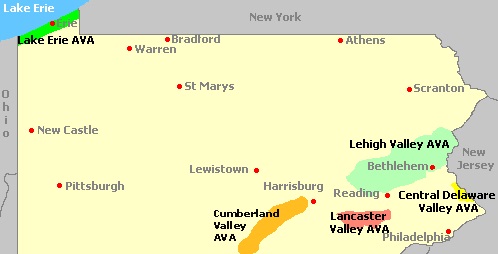
Lake Erie AVA
- The largest AVA in the state.
- Covers parts of Pennsylvania, New York, and Ohio.
- Moderated by Lake Erie, which extends the growing season.
- Known for its Concord and Niagara grapes used for sweet wines and juice.
- Also produces Riesling, Chardonnay, and Vidal Blanc.
- Some wineries are experimenting with Cabernet Franc and Pinot Noir.
Lancaster Valley AVA
- Located in southeastern Pennsylvania.
- Known for its limestone-rich soil.
- Benefits from a longer growing season than other parts of the state.
- Produces high-quality vinifera and hybrid grapes such as:
- Chardonnay, Cabernet Franc, and Chambourci
- Notable wineries include The Vineyard at Grandview and Waltz Vineyards.
Lehigh Valley AVA
- Located in eastern Pennsylvania.
- One of the most promising AVAs, with well-drained soils and rolling hills.
- The focus is on Cabernet Franc, Chambourcin, Grüner Veltliner, and Riesling.
- Home to Galen Glen Winery, which has gained national recognition for Austrian-style wines like Grüner Veltliner.
Cumberland Valley AVA
- Located in south-central PA, shared with Maryland.
- This AVA has a moderate climate suitable for vinifera grapes.
- Less prominent compared to other AVAs in the state.
Central Delaware Valley AVA
- Located along the Delaware River, straddling Pennsylvania and New Jersey.
- Produces a mix of vinifera and hybrid wines.
Main Grape Varieties
Pennsylvania grows a mix of vinifera, hybrid, and native American grape varieties.Vinifera (European varieties)
- Chardonnay is the most widely planted white grape. It is popular both as oaked and unoaked.
- Riesling thrives in the cooler parts of PA, making excellent dry, off-dry, and late-harvest wines.
- Cabernet Franc is the leading red variety. It performs well in PA’s climate, producing medium-bodied, herbaceous reds.
- Pinot Noir grows in selected regions, though challenging due to humidity and disease pressure.
- Merlot and Syrah are grown with moderate success in some regions the warmer southern parts of the state.
Hybrid Varieties
- Chambourcin – A versatile hybrid red, used in dry, semi-dry, and sparkling wines.
- Vidal Blanc – Ideal for sweet and ice wines, known for honeyed citrus notes.
- Traminette – A hybrid related to Gewürztraminer, producing floral, spicy white wines.
Native American Grapes
- Concord – Primarily used for sweet wines and grape juice.
- Niagara – A white grape known for its producing fruity, aromatic wines.
The Pennsylvania Wine Timeline
- 1683: William Penn plants bordeaux vines (carried over on his ship from England) on what’s now Lemon Hill in Fairmount Park. The vinifera grapes struggle to survive in unfamiliar territory but manage to pollinate native vines and produce the first American hybrids, known as “wildings.”
- 1767: Farmer Thomas Livezey discovers grapes growing on his Wissahickon Creek property. He makes wine from them and sends some to Benjamin Franklin in England, who reports back that the beverage is “excellent.” High praise from the statesman who once called wine “a constant proof that God loves us and loves to see us happy.”
- 1768: Local wines are exhibited at the American Philosophical Society, which piques the interest of entrepreneurs like John Leacock, who purchases a 28-acre Lower Merion plantation on which to grow wine. However, a little thing called the American Revolution gets in the way, leading Leacock to abandon wine dreams.
- 1787: Pennsylvania Vine Company, one of the first commercial vineyards in the country, is established by Pierre Legaux in Spring Hill, just outside Philly. Powerful men among its shareholders include Aaron Burr, Johns Hopkins, Alexander Hamilton and Robert Morris. Legaux is the first to get those tricky vinifera grapes to thrive, producing more than 20,000 mature vines.
- 1807: The German religious group Harmony Society brings commercial winemaking to southwest Pennsylvania. Its stone cellars, which held up to 30,000 gallons of wine, can still be viewed today on a tour of the Harmony Museum, located in (where else?) the borough of Harmony, population 1,104.
- 1900: By this time, 67 counties in Pennsylvania are producing some 200,000 gallons of wine annually, with Erie County leading the way. New Jersey is slightly ahead of us at 220,000 gallons. California, meanwhile, is producing over 20 million gallons a year.
- 1920: Pennsylvania’s wine industry comes to a halt with Prohibition. The production, distribution and sale of wine is illegal until 1933, when Prohibition ends and Pennsylvania establishes the Pennsylvania Liquor Control Board (PLCB) to oversee state stores. This marks the beginning of our state’s controversial liquor laws — some of the strictest in the nation.
- 1968: The Limited Winery Act is passed, letting wineries make up to 50,000 gallons a year using state-grown fruit; their wine can be sold directly to the public as well as to restaurants, nightclubs, hotels and the PLCB. The following year, Presque Isle Wine Cellars and Penn Shore Vineyards become the state’s first two licensed wineries.
- 2022: Pennsylvania’s roughly 300 licensed wineries produce more than two million gallons of wine a year. New and innovative wineries are being opened regularly, and folks are (finally!) starting to appreciate the unique qualities of Pennsylvania wine again. — E.M.
Published as “Vines of the Times” in the October 2022 issue of Philadelphia magazine.
US Wine Production 2023
California has the dominant role in U.S. wine production, producing more wine (680 millon gallons) than all other states combined.
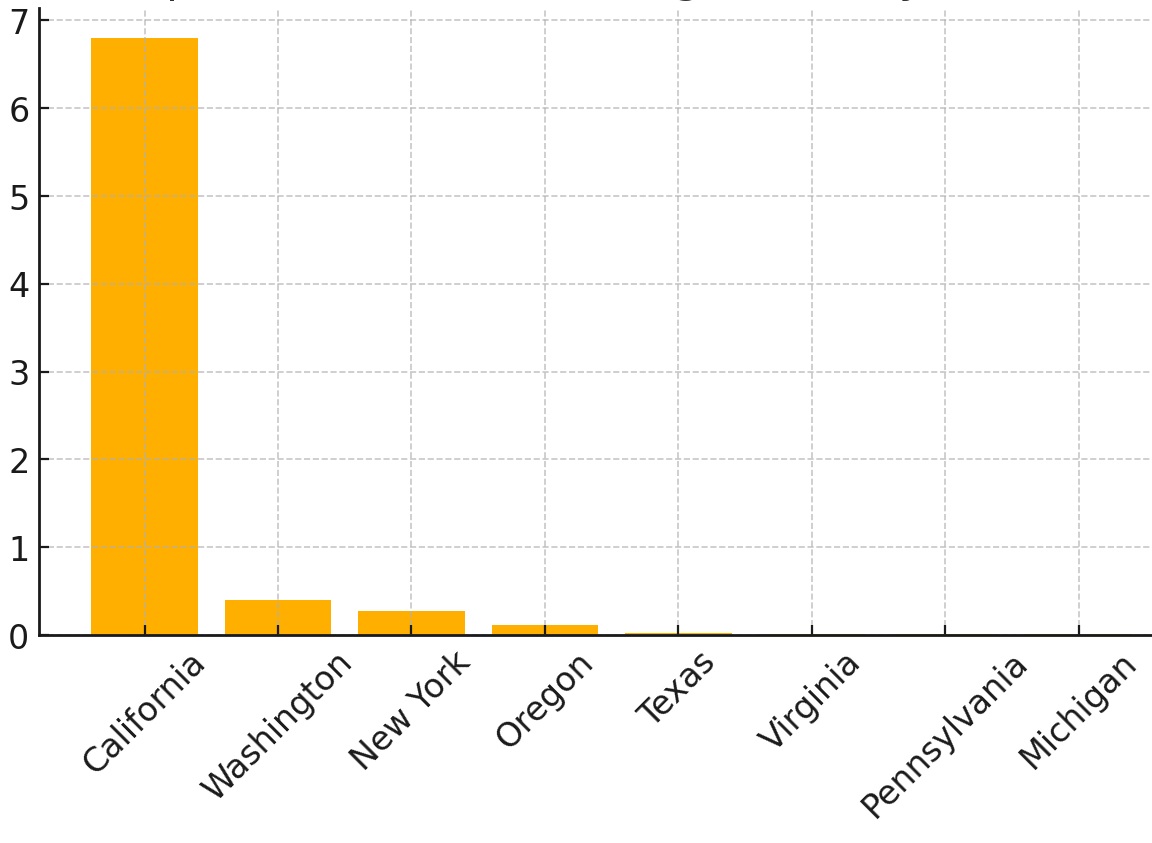
| State | Gallons | Hectares |
|---|---|---|
| 1. California | 680.0 million | 240,000 |
| 2. Washington | 41.0 million | 24,000 |
| 3. New York | 28.0 million | 14,500 |
| 4. Oregon | 12.0 million | 13,000 |
| 5. Texas | 2.1 million | 3,200 |
| 6. Virginia | 1.9 million | 1,800 |
| 7. Pennsylvania | 1.8 million | 1,600 |
| 8. Michigan | 1.5 million | 1,400 |
| 9. Missouri | 1.0 million | 1,300 |
US Grape Plantings
| Grape | Hectares |
|---|---|
| Chardonnay | 36,000 |
| Cabernet Sauvignon | 34,000 |
| Pinot Noir | 22,000 |
| Merlot | 19,000 |
| Zinfandel | 18,000 |
| Syrah | 9,000 |
| Sauvignon Blanc | 8,000 |
| Pinot Grigio | 7,000 |
| Petit Sirah | 4,500 |
| Riesling | 4,000 |
